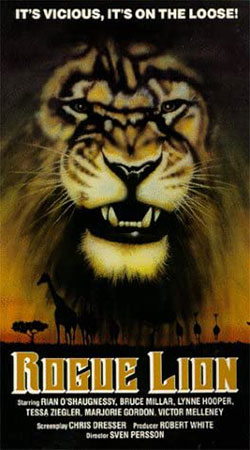
117. “Rogue Lion”
In 1972 I was just finalizing the shooting of a documentary on Soweto (the African township on the outskirts of Johannesburg) when Sven Persson, who had acquired the commission to make the Soweto documentary, asked me to write a feature film. Sven was born in Sweden but, after coming out to South Africa, he loved the country so much that he decided to stay. He was primarily a cinematographer but also became a director/producer. He had always wanted to direct a feature film and finally a storyline presented itself that he felt he could tackle.
In the course of making numerous wildlife documentaries, Sven had become friendly with Dr. Ian Player, a world-famous conservationist – and brother of the golfer Gary Player who was one of the global big three of golf in the ’60s and ’70s: Arnold Palmer, Jack Niklaus and Gary. Ian told Sven enough of his early life as a game ranger with the Natal Parks Board to give Sven a rough idea for an action/adventure story. Sven and I were working well together on the Soweto film. I had written the script and was doing production for Sven as director/cameraman. He was called away urgently to Britain, leaving me to direct a portion of the Soweto film with a cameraman he had hired. Sven was pleased with the footage I had directed, and he had enough faith in my writing skills to ask me to write a screenplay based around Ian Player’s early life.
I had for some time wanted to write a feature film. Much as I loved the documentary projects, my ultimate goal was to write features and possibly direct one at some stage. This was my chance. Sven and I met with Ian a couple of times where he told me about his early days as a junior game ranger. There was plenty of material for me to piece together a story. Very briefly, Ian joined the Natal Parks in the 1950s. It was a time when local famers lobbied to have all the larger wildlife destroyed in the area. Wildlife attracted the dreaded tsetse fly which does not affect indigenous animals but can be fatal both to domestic cattle and to humans. Farmers in northern Natal were mostly ex-servicemen who (as a reward for their military service in World War II) had been given farmland in order to make the previously undeveloped land more productive. Now, with the advent of game parks and reserves like Hluhluwe-Imfolozi and Ndumo on the Mozambique border, the deadly tsetse fly posed a real threat to their livelihood, as well as the danger to the farmers and their families contracting the disease known as “sleeping sickness.”
Apart from the conflict between the farmers and the game parks, Ian also mentioned an incident that could have had fatal consequences. A very young and newly qualified game ranger was concerned about the fact that there was only one lion in the entire reserve. He felt that the animal must be very lonely. So, with the best of intentions, he bought a circus lioness, smuggled her into the reserve and set her free. In his ignorance, he failed to realize that a lioness held in captivity for many years had completely lost the ability to hunt for its food. In a week or so, the poor lioness was literally starving, and in desperation it broke into the home of one of the rangers. The ranger came home to find the lioness in the hallway of his house and ready to attack any living creature that might provide it with food. Somehow, the experienced ranger managed to escape, grab his rifle and do what any conservationist hated most to do. He shot the lioness. The young ranger was severely reprimanded and lucky to keep his job.
These two elements provided me with the basis for a storyline. I wove an action/adventure around life in the reserve, as well as a conflict between a fictional senior ranger and his wife. Despite Sven’s considerable experience as a top-class filmmaker, he had not yet directed a theatrical feature film. So, it was a case of a first-time screenwriter and director coming together to make a picture. Against my wishes, it was called “Rogue Lion.”
Sven had persuaded two brothers, the owners of a large construction company called Bester Homes, to finance the picture. They had absolutely no experience with movies, but they had made a fortune building medium- to low-cost housing. They had already purchased an oceangoing racing yacht, Jacaranda, which had participated successfully in the annual “Cape to Rio” yacht race. This indicated a willingness to splash their money around, which is presumably why Sven approached them.
Although I was primarily concerned with the writing of the screenplay, Sven kept me in the loop as the production came together. Sven was effectively producing as well as directing. The Bester Homes brothers had appointed an architect (who was also the manager of the yacht Jacaranda) to look after their interests regarding the film. In fact, he was officially appointed the film’s producer although he didn’t have a clue about the movie industry.
Nevertheless, he certainly played the part – based on the Hollywood concept of the producer figure. He was a handsome man and would arrive on the film location in a flashy sports car, usually accompanied by an attractive dolly bird on his arm. Frankly, he just got in the way and complicated Sven’s life for the duration of the movie.

Sven did his own casting. There was no budget for international actors, but he did secure a very experienced actor to play the senior game ranger: Brian O’Shaughnessy, who had acted in numerous US and British pictures made in South Africa. His wife in the picture was played by Lynne Hooper, whose brother had been at school with me. She was a good actress and played the role of a neurotic wife very well. The part of the young ranger was played by Bruce Millar, whose background was in stage musicals but who managed the role quite well. Victor Melleney, another stage actor, was the leader of the angry local farmers. My old friend Ken Gampu played a local African chief. The only hassle I had with the cast regarding the screenplay was with Brian who wanted to rewrite almost all of his own dialogue. I was told that he did that whenever he thought he could get away with it. I was grateful when Sven put his foot down and told Brian to use the dialogue I had written, with a couple of exceptions that I agreed worked better the way Brian wanted them.
The production was marred by the death of three crew members, all in separate incidents. A young female assistant was killed on her motorcycle; the second I don’t remember but I think it was also off the film set. The third will remain in my mind forever. The sound engineer, Jimmy Chapman, was a veteran of both British and South African moviemaking. He was in his late sixties and had a fund of storytelling about the movie industry. He was much loved by everyone on the crew.
Jimmy always slept in the open air on a camp bed. The lion to be filmed inside the ranger’s house was driven down from Rhodesia (now Zimbabwe) in the back of a van. Due to poor communication, an enclosure that should have been erected before the lion’s arrival had not been completed. The lion was forced to sleep that night in the back of the van. It was fed but, unfortunately, some donkeys on a nearby farm kept braying through the night and the lion finally broke the wire mesh and escaped from the van in search of the donkeys. It was in most respects a well-trained lion that had just finished filming with British star Jack Hawkins in Rhodesia. It was so tame that it would often sleep on his owner Ossie Bristowe’s bed at night. Failing to find the donkeys, it roamed around, saw Jimmy’s camp bed, and decided to sleep on it with Jimmy. As the fates would have it, Jimmy, if woken unexpectedly, would always lash out with his fists and in this instance did so, hitting the lion. Even a semi-tame wild animal will react to a perceived attack and Jimmy was quickly overcome by the huge beast lashing out with its fearsome claws. The poor man died; his gruesome remains were found the following morning.
The blame should have fallen on the production manager for failing to provide the promised enclosure, but the lion’s owner and handler was initially charged with manslaughter – which was unfair and quickly squashed. Sven fired the production manager and then turned to me to take over production management for the rest of the film. I had never handled a feature production before. Luckily, my experience as a TV studio manager, as well as producing some documentaries I had also written and directed, enabled me to see the job through without hiccups.
The dramas didn’t end there. The picture went way overbudget and the Bester Homes brothers refused to pay for any publicity. Then, just before the picture was released, the distributor told our famous architect/producer that it was overlength and had to be cut by twelve minutes. Instead of calling on Sven or even me to make the cuts, the man got hold of the editor and arbitrarily hacked the footage out of the picture, removing virtually all of Lynne Hooper’s dramatic scenes with her husband, Brian O’Shaughnessy. Her performance now made no sense, and the film was panned by the critics for weak characterization. Because the film had received no publicity, it was (thankfully) seen by very few people in that version and died at the box office.
However, Sven still believed in the picture. A year later he bought the rights from the Besters for next to nothing, re-edited it, restoring Lynne’s performance, and sold it to a US distributor, where it ran quite successfully as a “B” picture. Then, irony of ironies, the US distributor sold the TV rights to the South African Broadcasting Corporation where it was screened as the Saturday night “Movie of the Week”! It wasn’t a great movie, but it did start me on the road to writing theatrical features and TV series.
Sven, who died some years ago, was a very determined and persistent man, both charming and volatile on occasions but very sure of what he wanted to achieve, In some ways he reminded me of Peter Warren. Without these similar characteristics, Peter’s ExoTech would never have seen the light of day. Now, we know, it is gaining an unstoppable momentum towards an expected launch of ExoBrain III at the end of 2023.

